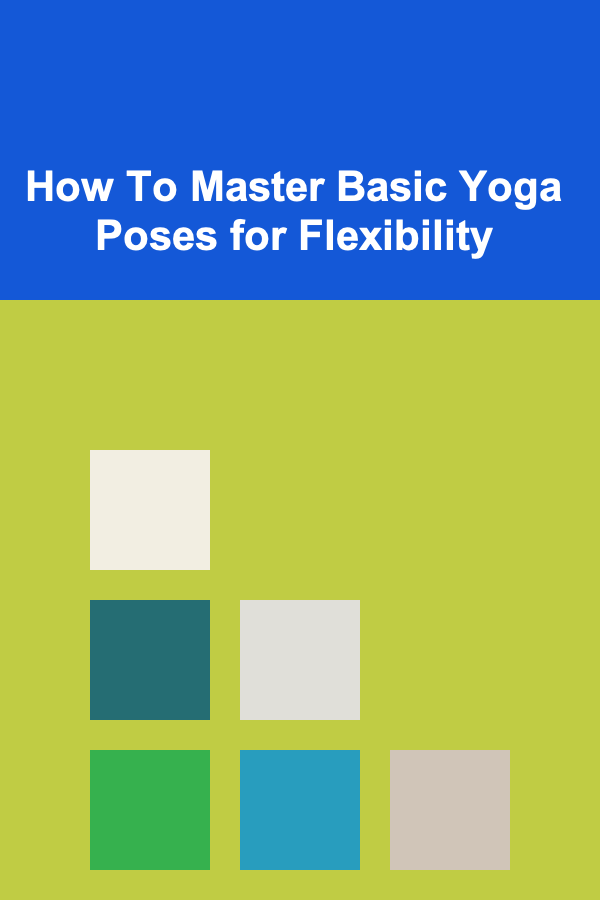
How To Master Basic Yoga Poses for Flexibility
ebook include PDF & Audio bundle (Micro Guide)
$12.99$8.99
Limited Time Offer! Order within the next:

Yoga is a holistic practice that integrates the mind, body, and spirit through movement, breathing, and meditation. It has been practiced for thousands of years and has gained immense popularity due to its numerous benefits, including increased flexibility, strength, mental clarity, and overall well-being. Among the many benefits yoga offers, enhancing flexibility stands out as one of the most common reasons individuals begin practicing yoga.
For beginners, flexibility can seem daunting, especially when it feels like you are not yet able to perform the poses as you see others doing them. However, mastering basic yoga poses for flexibility is entirely achievable with consistent practice, patience, and understanding of how the body moves.
This article explores how to master basic yoga poses for flexibility, offering a comprehensive approach that includes posture alignment, breathing techniques, and progress strategies. Whether you are completely new to yoga or looking to deepen your practice, this guide will help you take your flexibility to the next level.
Understanding Flexibility in Yoga
Flexibility in yoga is more than just the ability to touch your toes or bend your body into different shapes. It refers to the range of motion of your joints and muscles, and the ability of your body to move freely and comfortably. Flexibility can be divided into two key categories:
- Static flexibility: This refers to the ability to hold a stretch for an extended period, such as in a yoga pose like Downward-Facing Dog or Forward Fold.
- Dynamic flexibility: This refers to the ability to move muscles and joints through their full range of motion, often seen in flowing sequences like Sun Salutations.
In yoga, improving flexibility isn't just about gaining length in the muscles, but also about improving mobility and joint health. When you focus on increasing flexibility through yoga, you not only reduce the risk of injury but also enhance your ability to perform movements with ease and grace.
Benefits of Improved Flexibility
- Increased range of motion: A flexible body allows for greater movement, making everyday tasks easier.
- Reduced muscle tension: Flexibility helps reduce stiffness and discomfort in the muscles, allowing the body to relax and recover.
- Improved posture: A flexible body promotes better alignment and posture, alleviating common issues like back pain.
- Enhanced balance and stability: Flexibility is crucial for maintaining balance and coordination during yoga poses and other physical activities.
The Importance of Proper Alignment
Before diving into specific poses, it's essential to emphasize the importance of proper alignment in yoga. Proper alignment ensures that you are practicing safely and effectively, allowing you to deepen your flexibility without risking injury.
In many yoga poses, proper alignment involves creating a balance between lengthening the body and grounding it. For example, when practicing poses like Downward Dog or Warrior II, you must focus on creating space between your limbs, stacking your joints correctly, and engaging the muscles of the core to maintain stability. Without this awareness, you risk overstretching or straining your muscles, which can hinder your progress.
When learning basic yoga poses for flexibility, pay close attention to alignment cues provided by your instructor, whether in a class or through online resources. This will help you perform each pose safely and efficiently.
Breathing Techniques for Flexibility
Breathing plays a crucial role in yoga, especially when it comes to enhancing flexibility. Deep and conscious breathing helps relax the body, release tension, and deepen stretches. It also activates the parasympathetic nervous system, which promotes relaxation and allows the muscles to release more easily.
In yoga, the primary breathing technique used is Ujjayi Pranayama (victorious breath), where you inhale deeply through the nose, creating a soft sound as you engage the back of your throat. This technique helps maintain focus, control the breath, and create internal heat, which is particularly useful for increasing flexibility.
Here are some breathing tips to incorporate into your yoga practice:
- Inhale deeply to create space in your body and expand your ribcage.
- Exhale slowly to deepen into a stretch or hold a position.
- Use your breath as an anchor to guide your movements, syncing breath with each pose.
- Relax your facial muscles and jaw to release any unnecessary tension in your body.
By combining breath with movement, you can increase the duration of your stretches and avoid the discomfort that comes with trying to force yourself into positions. This will help your muscles release and lengthen more effectively.
Essential Basic Yoga Poses for Flexibility
Below are several basic yoga poses that can help improve flexibility, along with alignment tips and modifications for each pose.
1. Downward-Facing Dog (Adho Mukha Svanasana)
This pose is one of the most fundamental in yoga and is great for stretching the hamstrings, calves, and spine. It's a full-body stretch that helps lengthen and open up the body.
How to do it:
- Start on your hands and knees, with your wrists directly under your shoulders and your knees under your hips.
- Tuck your toes and lift your hips toward the ceiling, forming an inverted "V" shape.
- Keep your arms straight, with your fingers spread wide, and press your palms firmly into the mat.
- Lengthen your spine, pushing your chest back toward your thighs, and aim to straighten your legs.
- Keep your head between your arms, gazing at your feet or towards your thighs.
Key Tips:
- Keep a slight bend in the knees if your hamstrings are tight.
- Press evenly through your hands and feet to avoid collapsing in the chest.
- Focus on lengthening the spine rather than forcing the heels to the ground.
2. Forward Fold (Uttanasana)
A simple and effective pose to stretch the hamstrings, calves, and lower back. It also promotes relaxation and helps relieve tension.
How to do it:
- Stand with your feet hip-width apart and bend forward from your hips.
- Let your head hang toward the floor, and if possible, bring your hands to the ground or hold your elbows.
- Keep a slight bend in the knees if you cannot reach the floor with straight legs.
- Gently rock from side to side to deepen the stretch and release tension in the spine.
Key Tips:
- Engage your quadriceps to protect your knees.
- Don't force the stretch---allow gravity to assist in lengthening your back and hamstrings.
- Keep your neck relaxed and avoid tensing your jaw.
3. Low Lunge (Anjaneyasana)
This pose stretches the hip flexors, quads, and groin while also opening the chest and shoulders. It's great for those who sit a lot during the day and need to release tightness in the hips.
How to do it:
- Start in a tabletop position and step one foot forward, bringing it between your hands.
- Lower your back knee to the mat and press your hips forward, keeping your front knee aligned with your ankle.
- Lift your torso up, reaching your arms overhead, and gently sink deeper into the hips.
- Hold the stretch for a few breaths, feeling the stretch in the hip flexors and quads.
Key Tips:
- Keep your back leg straight, with the top of your foot pressing into the mat for stability.
- Engage your core to prevent arching your back excessively.
- If necessary, place a blanket under your back knee for cushioning.
4. Seated Forward Fold (Paschimottanasana)
This pose stretches the hamstrings, calves, and spine, and is excellent for improving flexibility in the lower body.
How to do it:
- Sit on the floor with your legs extended straight in front of you.
- Flex your feet and sit up tall, lengthening your spine.
- As you inhale, extend your arms overhead, and as you exhale, hinge at your hips to fold forward, reaching for your feet or shins.
- Keep your back straight and avoid rounding your spine.
Key Tips:
- Keep your legs engaged to protect your knees.
- If you cannot reach your feet, use a yoga belt or strap around the soles of your feet to gently pull yourself deeper into the stretch.
- Focus on lengthening your spine rather than forcing yourself into the fold.
5. Butterfly Pose (Baddha Konasana)
This pose helps open up the hips, groin, and inner thighs, making it an excellent stretch for flexibility in the lower body.
How to do it:
- Sit on the floor with your legs extended straight in front of you.
- Bend your knees and bring the soles of your feet together, allowing your knees to fall open to the sides.
- Hold your feet with your hands and gently press your knees toward the floor.
- Sit up tall and keep your spine straight.
Key Tips:
- Avoid forcing your knees to the floor---let gravity do the work.
- Focus on lengthening your spine rather than collapsing forward.
- To deepen the stretch, gently fold forward from the hips, keeping your back straight.
Patience and Progression: Flexibility Takes Time
One of the most important things to remember when working on flexibility is that progress takes time. It is essential to listen to your body, not rush the process, and avoid comparing yourself to others. Flexibility is a personal journey, and everyone's body has its own unique limitations and strengths.
To make steady progress, practice regularly and focus on gradual improvements. Start with shorter sessions and increase the duration as your flexibility improves. Pay attention to how your body feels after each practice, and allow for recovery time between intense stretches.
Conclusion
Mastering basic yoga poses for flexibility is a journey that requires patience, consistency, and mindfulness. By understanding the importance of proper alignment, focusing on your breath, and regularly practicing foundational poses, you can gradually increase your flexibility and reap the benefits of improved mobility, posture, and overall well-being.
Remember, yoga is not about achieving a perfect pose---it's about the process of self-discovery, listening to your body, and honoring where you are at each moment. With time, your flexibility will improve, and so will your connection to your body and mind.

Best Practices for Writing Copy for One-Page Websites
Read More
How to Choose Multi-Functional Furniture for Small Spaces
Read More
How to Enhance Your Home's Curb Appeal Without Sacrificing Security
Read More
How to Leverage Tax-Advantaged Accounts for Smart Investment Growth
Read More
Innovative Approaches: Transforming Organizations Through COO Leadership
Read More
How To Give Positive Reinforcement Regularly
Read MoreOther Products

Best Practices for Writing Copy for One-Page Websites
Read More
How to Choose Multi-Functional Furniture for Small Spaces
Read More
How to Enhance Your Home's Curb Appeal Without Sacrificing Security
Read More
How to Leverage Tax-Advantaged Accounts for Smart Investment Growth
Read More
Innovative Approaches: Transforming Organizations Through COO Leadership
Read More